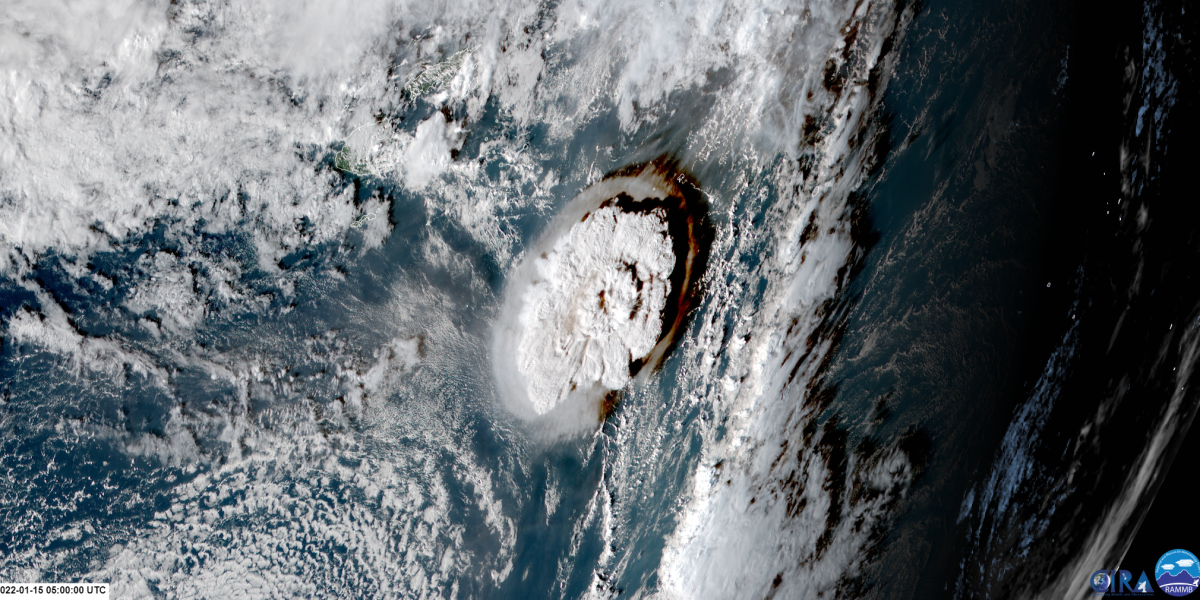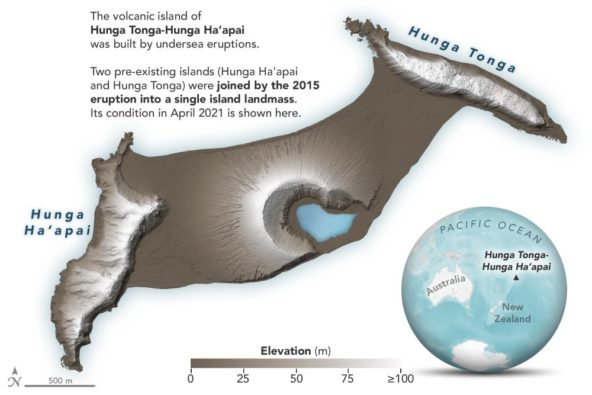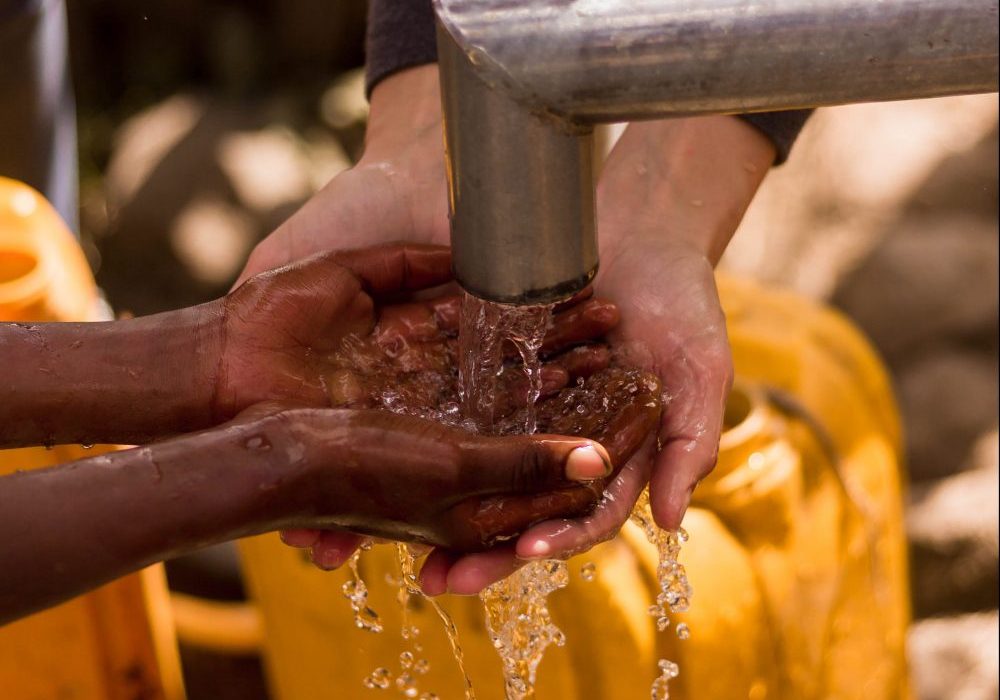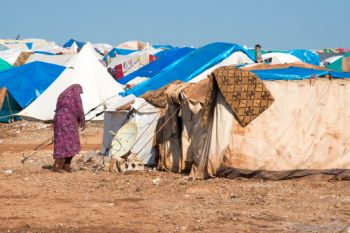

A Polynesian Kingdom, Tonga is composed of 169 South Pacific islands. Its population of just under 105,000 resides in one of 36 inhabited islands, with 70% of residents living on Tongatapu. New Zealand’s North Island is about 1,100 miles from Tonga.
The Hunga Tonga-Hunga Ha’apai volcano north of Tongatapu unexpectedly erupted on Jan. 14. This was the latest in a series of eruptions, there was no warning of the severity of this eruption and no opportunity to prepare for it.
Researchers determined, “at its highest point, the plume rose 36 miles (58 km) into the air, meaning it pierced the mesosphere — the third layer of the atmosphere … After an initial blast generated this towering plume, a secondary blast from the volcano sent ash, gas and steam more than 31 miles (50 km) into the air.”
(Credit: Himawari-8 ProxyVisible JPA – CIRA/RAMMB)
The eruption, which was clearly visible from space, sent tsunami waves rippling across the Pacific Ocean reaching as high as 49 feet (15 meters). The capital Nuku’alofa, located on the main island, just 40 miles (65 km) south of the volcano, saw waves of 4 feet (1.2m), while countries as far away as Japan and the United States reported waves between 1 and 4 feet.
The eruption broke two records: “The volcanic plume reached greater heights than any eruption ever captured in the satellite record, and the eruption generated an unparalleled number of lightning strikes — almost 590,000 over the course of three days.”
The blast was likely the loudest eruption since Krakatoa (Indonesia) in 1883. According to NASA researchers, the eruption generated an explosion as powerful as approximately 4-18 megatons of TNT, which is up to 1000 times more powerful than the bomb dropped on Hiroshima.
Prior to the eruption, the volcanic island was composed of two older islands that had been linked into one by land formed in 2015. The eruption destroyed all the new land, along with much of the older two islands.
What is the impact of this disaster?
According to an assessment by the World Bank, “The Tonga Hunga-Tonga-Hunga-Ha’apai volcanic eruption, tsunami and ashfall has caused an estimated US$90.4M (TOP 208 million) in damages – the equivalent of approximately 18.5% of Tonga’s Gross Domestic Product (GDP).

Every single school across Tonga was impacted by the volcanic eruption and subsequent tsunami, according to Save the Children staff. On the three main islands of Tongatapu, Eua and Ha’apai, there were three inches of sand and volcanic dust covering the schools. Textbooks, classroom furniture and writing materials were destroyed, and some classroom buildings were extremely damaged. Schools had opened on Jan. 31, but closed on Feb. 2 due to COVID.
The World Bank assessment also found, “Around 600 structures in total, including at least 300 residential buildings, have been damaged or destroyed by the tsunami waves in Tonga with an estimated US$43.7M of damage. Many tourism businesses have been particularly hard hit – with accommodation, wharves and worker’s homes destroyed or severely damaged. Tonga’s agricultural sector has been significantly impacted – with 85% of agricultural households nationwide affected to some extent, and an estimated US$20.9M of damage to this sector; including crops lost, and damage to shallow reef fisheries. The tsunami and volcanic ashfall caused an estimated US$20.9M in damage to infrastructure – including roads, causeways, power supply, ports/marine and water supply infrastructure as well as the submarine cable. Ash clean-up costs will be significant and are estimated to cost just under US$5M for buildings and paved road infrastructure.”
On Tongatapu five coastal communities were assessed with significant damage: ‘Ahau, ‘Atata, ‘Eueiki, Kanokupolu, and Patangata. At least 31 houses were destroyed, 72 were severely damaged, 46 had moderate damage and 23 hadminor damage. On ‘Eua, two houses were destroyed, 45 were severely damaged and 45 sustained moderate damage.
In the Ha’apai group of islands, Lifuka had 16 houses severely damaged along with damage to government buildings. On Mango Island, population 36 people, all houses were destroyed and on Fonoifua only two houses remain (population 69 people). The residents of these two islands were evacuated to Nomuka, which also experienced significant damage.
The islands of Niuas and Vava’u had no significant damage visible from a reconnaissance flight except for a light covering of ash..
On Feb. 22, the underwater communication cable that connects Tonga to Fiji was restored after the state-owned company laid 56 miles of cable, some of which they needed to borrow from other companies. “Tonga’s submarine fiber-optic cable system connects the main island to Fiji, whose international network connects it to the rest of the world … Now, they can focus on repairing the second domestic cable connecting to Tonga’s outer islands.” Elon Musk’s SpaceX company donated 50 very-small-aperture satellite terminals (VSAT) to the Tonga which have allowed access to the outer islands in the meantime.
Volcanic ash covered all surfaces, including trees and homes in Tonga. Water infrastructure remains severely compromised.
Who is affected and in what ways?
At least 80% (about 84,000 people/12,000 households) of the population was affected. As of Jan. 31, there were still 2,390 people/465 households that were still displaced. Over half of these were on the main island.
According to UN OCHA, “It is estimated that more than 32,000 children have been psychologically affected by the emergency. More than 30,000 people have been reached with WASH assistance so far. An estimated 15,000 persons have been reached with health assistance and some 10,000 persons with nutrition assistance. Emergency shelter and NFI assistance was distributed to 2,020 people in most-affected areas. The loss in the agricultural sector is estimated at US$ 17 million, according to the Ministry of Agriculture, Food and Forests.”
As of Feb. 23, only three people were reported to have died in Tonga. One of them, a British national who ran an animal shelter, was swept away by floodwaters while saving her dogs. Elsewhere, two people died in Peru because of the tsunami waves.
Health care
The government asked people to wear masks and drink bottled water to protect against the ash. Survivors will likely need treatment for respiratory issues due to the ash.
COVID-19
Prior to the volcanic eruption Tonga had only seen one case of COVID-19 (in October 2021 from an external transmission). Since then, there have been an additional 233 cases, from community transmission.
As of Feb. 28, 66.5% of the population is fully vaccinated. There were concerns from the beginning that allowing aid workers into the country would result in the pandemic spreading among the population. Despite strict COVID-19 protocols, these fears were realized, and as of April 11, there have been 8,444 cases, mostly from community transmission.
Colonization saw one-quarter of the population killed in late 19th century due to measles and in 1918, 8% of the population died from the Spanish Flu after it was introduced by a New Zealand steamship.
Water, Sanitation and Hygiene
While CDP does not recommend importing bottled water to a disaster zone, especially in an island setting, there will be a need for water desalination, clean out of water infrastructure and delivery of tanks of water until other systems are established. Water infrastructure and sewage will be affected, so sanitation and hygiene will also need to be supported.
Safe spaces for children and other at-risk groups
After all disasters, protection is an important component to ensure safety, create a sense of normalcy and help with recovery from stress and trauma, which requires psychosocial support.
Education
Every single school in Tonga was affected. From buildings to books, everything in most schools will need to be replaced or repaired, as well as undergo extensive cleaning.

The Center for Disaster Philanthropy (CDP) has a Global Recovery Fund (select 2022 Tonga Volcanic Eruption) that provides an opportunity for donors to meet the ongoing and ever-expanding challenges presented by global crises.
Contact CDP
Philanthropic contributions
If you would like to make a donation to the CDP Global Recovery Fund, please contact development.
(Graphic: NASA Earth Observatory)
Recovery updates
If you are a responding NGO or a donor, please send updates on how you are working on recovery from this disaster to Tanya Gulliver-Garcia.
We welcome the republication of our content. Please credit the Center for Disaster Philanthropy.
Donor recommendations
If you are a donor looking for recommendations on how to help with disaster recovery, please email Regine A. Webster.
Philanthropic and government support:
In partnership with Google, CDP issued a $102,475 grant in March 2022 to CARE to support the immediate relief and recovery of people most directly affected by the eruption of the Hunga Tonga–Hunga Haʻapai volcano and to improve disaster preparedness and mitigation capacity of at-risk communities in Tonga. The program activities will be implemented by two local Tongan NGOs (Talitha and MORDI) and will include the provision of shelter repair and household hygiene items, psychosocial support for women and children in safe spaces, and rehabilitation of water catchment systems for the most affected households.
As with most disasters, cash donations are recommended by disaster experts as they allow for on-the-ground agencies to direct funds to the greatest area of need, support economic recovery and ensure donation management does not detract from disaster recovery needs.
If you are considering supporting an organization positioned to work in an affected area, do some research. CDP and InterAction can provide resources and guidance about organizations working in affected communities.
A donor briefing by the Pacific Humanitarian Team of UN OCHA saw a good response with the following contributions in money or in-kind aid announced.
- Japan: Emergency grant aid of $1 million, plus it is sending drinking water, equipment to remove volcanic ash and other relief supplies, and mobilizing Japan Self Defense Forces. All in close cooperation with Australia and New Zealand.
- Australia: $724,500 (AUD $1 million)
- New Zealand: $677,302 ($1 million NZD)
- United States: $100,000
- China: $100,000
- Norway: $50,000
- World Bank: $8 million
- Asian Development Bank: $10 million
On Jan. 21, the Tongan Government announced “a cash grant to households that have sustained severe damage, a monthly stipend to the elderly and those with disabilities.”
Related resources

Water, Sanitation and Hygiene (WASH)
Water is one of the most necessary elements for life, yet according to the World Health Organization/UNICEF, 2.1 billion people lack access to safely managed drinking water. In addition, 4.5 billion people lack safely-managed sanitation facilities. Water, sanitation and hygiene (WASH) principles are of tremendous concern in everyday life, but can be heightened during an emergency or disaster.

Emergency and Interim Shelter
After a disaster, shelter is more than a place to rest, it is a place of security, access to food, water and medical treatment. A place to start recovering after a disaster.

Is your community prepared for a disaster?
Explore the Disaster Playbook